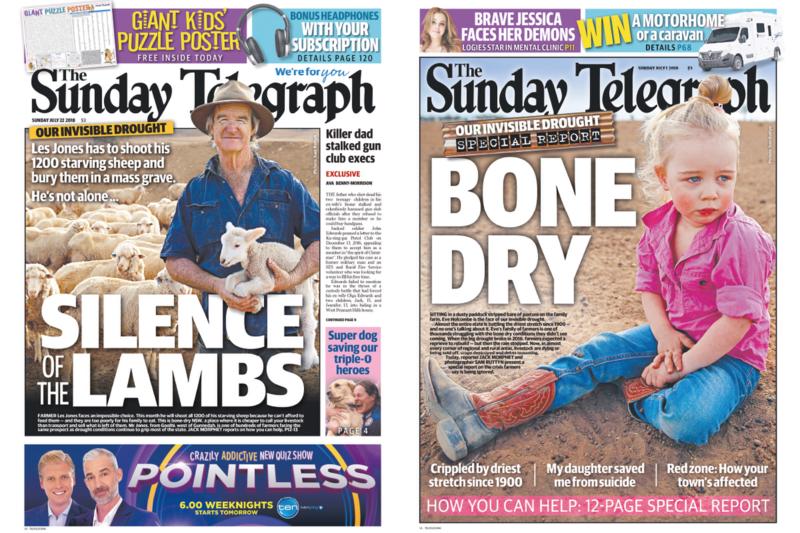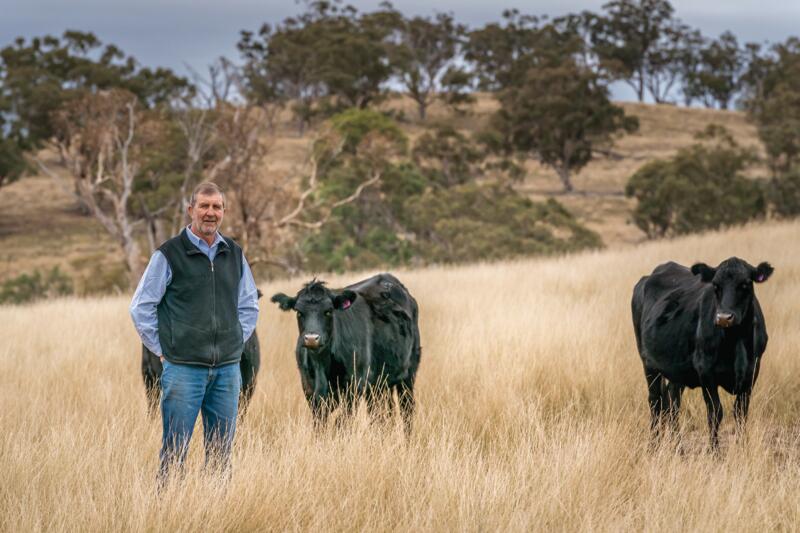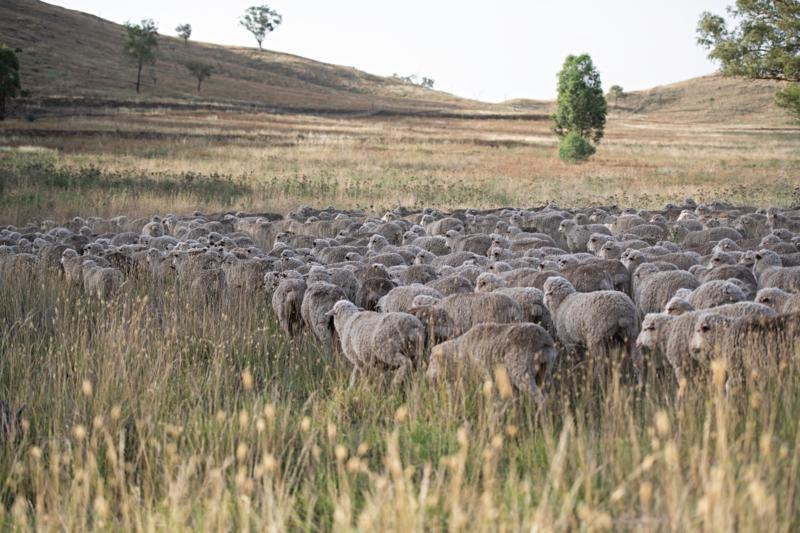AMID one of the driest times in Australian history, with an El Niño on the horizon – there’s an inevitable sense of uncertainty for farmers and the hungry mouths they feed.
With such pressure, the need to adapt, produce more with less and add value becomes even more critical, so it’s no surprise the media has been hot on the issue – or at least it was last year.
The role of the media and the perception it relays to consumers and even foreign trade partners is a contentious topic, hotly debated at the Global Food Forum (GFF) in Sydney in late March, where farmers, journalists and agribusiness leaders met to discuss the future prosperity of agriculture.
 Emotive headlines: there was a concentrated focus on the drought by newspapers, television and the internet in mid-2018. This was later followed by ‘Adopt a Farmer' campaign launched in May 2019.
Emotive headlines: there was a concentrated focus on the drought by newspapers, television and the internet in mid-2018. This was later followed by ‘Adopt a Farmer' campaign launched in May 2019.
“If you look at productivity in the last year, we’re still a $60 billion industry that’s driven by the same farmers that were there before,” said Tim Burrows, Agribusiness Australia chief executive officer, who spoke on a GFF drought-proofing panel.
“Our farmers have one of the most noble careers and were being treated as a charity case,” Tim said when the discussion turned to the media and its portrayal of producers.
RELATED: 'We are not just farmers'
“We needed farmers to be respected for how they were managing the current situation as they have over many decades – not turned into charity cases where people were giving away a few dollars.” – Tim Burrows.
 Farmers like Tony Hegarty proactively de-stocked their properties to preserve their pastures and ecology of the land during drought. Photo by: Joan Faras.
Farmers like Tony Hegarty proactively de-stocked their properties to preserve their pastures and ecology of the land during drought. Photo by: Joan Faras.
Agricultural journalist Sue Neales moderated the panel, ‘Can Australian agriculture be de-risked and drought-proofed’, and she began by discussing how and when the media first reported on the issue.
“It happened last year in about April. Everybody in Sydney and Melbourne suddenly heard about Australia being in this terrible drought – NSW in particular, even though Queensland had been in drought for six years,” Sue said.
“It all happened very quickly in the media, suddenly farmers were all starving, their animals were starving and it was a huge problem. I do think the media has to be more responsible and that comes back to the fact that most journalists don’t have the agricultural knowledge, the education and don’t understand science, soils, rainfall and El Niño. It’s been an issue in the journalism community for quite a long time.”
RELATED ARTICLES ON DROUGHT:
-
Drought declarations: for or against?
-
Regenerating land with drought-proofing tool
-
Building resilience to drought
-
Climate change wreaking havoc
You have these emotive stories and painful images of dying lambs, she said, but the fact is 80-90% of farmers aren’t actually like that. She posed the question, “Is this a fair portrayal of the average farmer?”
A poor portrayal of the agricultural industry
The industry is running well, Tim replied, despite this negative coverage.
“Agriculture is stable, well-managed and needs to be seen as an attractive investment.” – Tim Burrows.
The way we communicate about the industry to the world is critical, said Gillian Sanbrook, a regenerative farmer of
Bibbaringa Beef in Wymah Valley, NSW, who also joined them on the panel.
The dam doesn’t sink overnight, she said, there’s a warning there before the dam gets that low and you should have offloaded stock earlier.
“When the NSW government announced from August last year that 100% of NSW was in drought, I thought, well it’s not that bad here. It’s dry but it doesn’t deserve that status,” Gillian said.
“At that stage there had been some bad situations and there’s always going to be an element of people where they can’t see themselves getting out of it.” But this is not the majority, and is not good for international relations or financial property, she added.
 Many farmers, through agricultural nous, drought-proofing and forethought are able to make the best of a bad situation but the media coverage can be damaging for future investment and trade partners. Photo by: Pip Farquharson.
Many farmers, through agricultural nous, drought-proofing and forethought are able to make the best of a bad situation but the media coverage can be damaging for future investment and trade partners. Photo by: Pip Farquharson.
Gillian believes
negative language being used has a direct impact on the outside perception of the industry. “I don’t use the word drought. I’d refer to it as, ‘it’s a dry time’. We were quite moved to be active during this dry time and we did have a plan [on our property],” she said.
Tim added: “Drought is an emotive word in our community that is becoming more and more significant because more people don’t have an uncle or aunt on the farm anymore, so it’s the end of the road there for them.”
There is a sense of fear as farmers produce food for the population, Gillian added, which means Australia needs to look at how we manage our resources.
“There is huge stress on water – and I think we could do a lot better in how we’re managing our land and what we’re producing off it,” she said.
RELATED: The truth about the Murray-Darling
There is a greater movement to support regenerative agriculture, Gillian said, and now there are carbon audit opportunities for farmers.
“We’ve planted 70,000 trees at Bibbaringa. We started with 13 paddocks and now we have 26 and we’re really into improving that ground cover with the view that soil carbon may be tradeable some day.”
RELATED: Improving pasture growth with carbon grazing
Investment needed to grow farming industry
The surging demand for food requires major investment to improve production but traditional approaches to farming finance are falling short, according to Greensill Capital, which provides working capital finance for companies.
Queensland farmers and brothers, Lex and Peter Greensill, spoke at the GFF about their latest approach to funding methods that uses technology and capital markets to help farms keep up with the investment needed to meet the increasing global demand for food.
Bundaberg-bred brothers Lex and Peter Greensill combine farming with big business. Source: Supplied.
Greensill co-founder and CEO Lex said: “Growing up on my family’s sugar cane farm in Bundaberg, I saw firsthand how working capital pressures can hobble an otherwise successful business.”
RELATED: Could Wagga become the next Silicon Valley?
National Australia Bank general manager of agribusiness Khan Horne spoke at the forum about better ways to finance agriculture in light of the Banking Royal Commission.
“It’s one of the toughest seasons I’ve seen in my career, so we’ve made a commitment for
no closures of rural banks before 2021,” Khan said.
We’re building trust in the environment, he said to support farmers during this period. “It’s not like lending to Sydney or Melbourne residents. I think the modelling has got to be absolutely best-case worst-case average. We must understand the assumptions.”
“Land is 80% of finance inventory – we need to be looking at natural capital and looking to a multi-decade horizon that supports forecast plans and systems, where assets are measured by soil and water improvement,” Khan said.